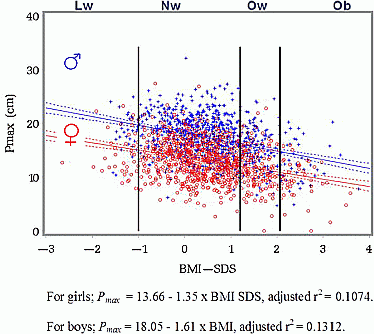ESPE2015 Poster Category 2 Growth (38 abstracts)
The Pubertal Gain in Height is Inversely Related to BMI in Childhood
Anton Holmgren a, , Aimon Niklasson a , Andreas F.M. Nierop c , Lars Gelander a, , A. Stefan Aronson b , Agneta Sjöberg e , Lauren Lissner f & Kerstin Albertsson-Wikland g
aDepartment of Pediatrics, Institute of Clinical Sciences, Sahlgrenska Academy, Göteborg Pediatric Growth Research Center, University of Gothenburg, Gothenburg, Sweden; bDepartment of Pediatrics, Halmstad County Hospital, Halmstad, Sweden; cMuvara bv, Multivariate Analysis of Research Data, Leiderdorp, The Netherlands; dAngered Hospital, Gothenburg, Sweden; eDepartment of Food and Nutrition, and Sport Science, University of Gothenburg, Gothenburg, Sweden; fDepartment of Public Health and Community Medicine, Institute of Medicine, The Sahlgrenska Academy of Gothenburg, Gothenburg, Gothenburg, Sweden; gDepartment of Physiology/Endocrinology, Institute of Neuroscience and Physiology, The Sahlgrenska Academy, University of Gothenburg, Gothenburg, Sweden
Background: Weight in childhood may influence the pubertal timing and pattern of growth.
Objective: To investigate the impact of BMI in childhood on further growth, especially the specific pubertal pattern of growth.
Method: The longitudinally followed GrowUpGothenburg1990 birth cohort, was analyzed using the QEPS growth model (Nierop et al. Horm Res in Ped. 2013; 80(suppl 1):152–153) (describing total height as a combination of four mathematical functions; Quadratic – Q, Exponential – E, Pubertal – P and Stop – S). Individual BMISDS values, from 3.5–8 years of age were calculated for linear and subgroup analyses (low/normal – Lw/Nw, overweight/obese – Ow/Ob), based on the IOTF 2012 reference (Cole TJ, Lobstein T. Pediatric obesity. 2012; 7(4):284–94.).
Results: Across the whole BMI range a negative dose-response effect of childhood BMI on pubertal gain (Pmax) was found. Already at birth Owob children were heavier, and they grew faster in height in the prepubertal period compared to Lw/Nw, as evidenced by an increased Q function. Owob children of both genders had earlier puberty (91–117 days), P=0.0004, reduced growth during puberty, boys/girls 3.13/2.26 cm less pubertal gain P=0.0001, from the specific pubertal growth function (Pmax). The adult height was not related to BMI in childhood.
Conclusion: The higher BMI in childhood, the faster the prepubertal growth, the earlier onset of puberty, the less pubertal gain. This was evident across the whole BMI-range, making weight status an important modifier of growth.
Funding information: This work was supported by the Swedish Research Council (VR no 7509 and VR 2006-7777), VR/FORMAS/FORTE/VINNOVA (259-2012-38 and 2006-1624); EpiLife-TEENS research program, Pfizer AB, the Governmental Grants for University Hospital Research (ALF), the R&D Department, County of Halland, and the Foundation Växthuset for children.





